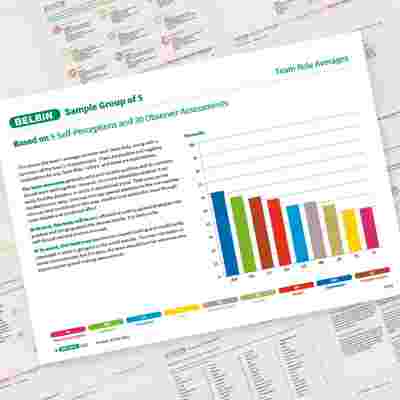Key takeaways
- A team social contract is a shared agreement about how members work together, promoting clarity and collaboration.
- Without explicit agreements, teams often default to unspoken norms that limit trust and performance.
- Research shows most teams lack accountability, open feedback, and shared focus – key reasons they underperform.
- High-performing teams define and commit to clear behaviours that support candour, ownership, and growth.
- Belbin Team Roles help teams understand individual contributions, making it easier to develop meaningful social contracts which enable more effective collaboration.
A social contract details how team members will behave with one another, enabling everyone to work together more effectively.
Social contracts offer clarity and improve communication within teams. They set out the ways that team members will behave and interact.
An explicit vs. implicit social contract
To achieve high performance, it is crucial that team members put an explicit social contract in place, by agreeing on accepted behaviours. Without an explicit social contract in place, it is difficult for teams to cultivate psychological safety and reach their full potential.
This is often because an implicit social contract forms in its stead. In other words, there are unspoken rules that govern the way people work and communicate, but these may not be known to (or agreed by) everyone, may be broken unwittingly or without repercussions, and may not serve the team.
For example, team members have an unspoken agreement to avoid conflict, stick to their own areas of responsibility and not to speak their minds in front of managers. They may also refrain from giving and accepting feedback from peers.
According to the Greenlight Research Institute:
- 71% of team members aren’t committed to elevating one another by offering feedback on professional capabilities, business practices and performance;
- 71% don’t believe that their team collaboratively engages in the most important business problems across the organisation;
- 74% don’t agree that their team is accountable for shared goals;
- 81% say that their team is not operating anywhere near its full potential.
For leaders and teams that seek higher performance, innovation and growth, commitment to an explicit social contract is essential.
"To achieve breakthrough performance, teams should commit to a new social contract that emphasises candour, collaboration, accountability and continual improvement."
– Harvard Business Review
Innovation, decision-making and growth
HBR describes how a global consultancy helped a multinational producer of automated test equipment to shift focus from leadership competencies and top-down control to rediscovering "what it means to be a great team".
In effect, this meant transforming teams – fostering a culture of trust and faster, collaborative decision-making, in order to accelerate innovation and growth.
To do this, teams addressed their essential team behaviours and decided which were serving the team and which were not.


Asking the right questions
In order to establish the status quo, teams can ask:
- Do we avoid conflict? Do we challenge one another and speak openly about problems, even when it is difficult or when it falls outside our immediate area of responsibility?
- Do we often work in silos or do we collaborate? Do we create shared value from those collaborations?
- Do we operate under a hierarchy? Or do we build authentic relationships with stakeholders?
- Do we meet our goals and commitments? Do we hold each other accountable? Are we willing to do whatever it takes to ensure shared success?
- Are we engaged? Are we constantly searching for ways to grow? Do we coach one another to get there?
- Are we committed to other team members? Do we celebrate each other’s achievements and express gratitude?
- Are we achieving our full potential as a team? Are we able to innovate and transform as a result?
Analysing your team’s behaviours with Belbin
Once the team has established that members have the desire to make changes, they can begin to explore which behaviours can make the biggest difference to performance. Once changes are evident, they can begin to expand this to more practices.
This is where Belbin comes in. Belbin Team Roles are clusters of behaviour which were shown to be effective in facilitating team progress.
Understanding our own Team Role strengths, those of others in the team and the overall Team Role culture can help teams navigate the conversation around useful team behaviours.
Describe your team
The Belbin Team report provides a list of words and phrases which characterise the team, according to its members. When considering existing behaviours (and what a social contract might look like), this list can be useful in identifying those behaviours which do, and do not, serve the team.


Your Team Culture
The report also gives an overview of the team’s prevailing Team Role culture. This enables teams to identify the most common behaviours (which might be contributing to the implicit social contract) and those which might be in short supply and therefore need special attention.
For example, a predominantly Implementer team is likely to value efficiency and methodical working. They may be resistant to change, so may find that individuals are reluctant to challenge the status quo. By contrast, team members who share Shaper behaviours might have no problem in challenging one another, but might struggle with political infighting and supporting one another.
The Team Roles which feature lowest on the graph can help the team to identify characteristics which are rarer in the team and should be valued and promoted to ensure behavioural diversity, which is shown to enhance team performance.
For example, a team with lots of Monitor Evaluator influence and one strong Plant might want to include in their social contract the notion that ideas should be valued and analysed judiciously, not treated with cynicism or dismissed out of hand.
Join over 25,000 people who receive our research and insights once a week. Unsubscribe any time.
Strategies to help teams embed lasting change
Behavioural changes of any kind require conscious effort in order to become habit-forming.
HBR suggests three strategies to ensure sustainable change.
Collaborative problem-solving
According to this strategy, a single business-critical question is discussed for 60-90 minutes during which members draw together data and insights without the pressure of forming consensus.
Leaders are clear from the outset as to who will make the final decision, to avoid resentment later.
The team breaks out into sub-teams of three to brainstorm and critique. (The smaller numbers lower inhibitions so that team members can be more candid.) The sub-teams report back to the group and each idea receives feedback.
The team documents the discussion and the outcome – it is essential that an action follows!
Instead of imposing solutions (or decisions) from above, this strategy allows the team to understand the intent behind a new initiative, which increases buy-in.


Bulletproofing
In this strategy, one team member presents a project: what’s been achieved, where it’s struggling, and what’s planned next. They ask for candid feedback and constructive criticism.
The three-person sub-teams go off to identify possible risks and brainstorm ways to mitigate them. They may also offer challenges, innovations and offers of help.
The result? The team member is offered a variety of perspectives and approaches, involving peers in developing a solution without lessening authority.
Bulletproofing ensures that teams collaborate across silos and share collective responsibility. It leads to ‘bolder, more inclusive collaboration and faster decision-making’.
In Belbin terms, it can be useful to understand how people with different Team Role strengths can contribute at various stages of a project. Click here to read more.
Candour breaks, red-flag replays and safe words
Conflict avoidance in teams can be extremely damaging. If team members are unable to be candid, they can miss out on opportunities or become needlessly exposed to risks.
Instead, team members need to be given permission – and a structure – to air their concerns.
A candour break is when someone is able to stop and encourage the team to reflect on what isn’t being said?
A red-flag replay, as in sports, can help teams to discuss why and how a violation of the social contract occurred, so they can get the team back on track and strategise for next time.
An agreed safe word or phrase cues everyone to stop and listen attentively without interrupting. This is useful when things have gone off track or when someone has something particularly important or controversial to say.

"Without team-specific coaching and development, the work is indeed harder than it needs to be, and collaboration is less effective – so workloads become even heavier, making people feel even more overwhelmed and less able to pursue development and growth."
– Ferrazzi Greenlight
Feedback within the team: the key to developing a meaningful social contract
To improve performance, it is essential that team members are able to give and receive feedback – to coach one another, rather than relying solely on input from a manager.
The problem is that many tools focus on personality and are self-reporting. (In other words, they rely on an individual’s self-insight and don’t incorporate feedback from others.)
As a result, the ‘type’ identified may not resemble the person the rest of the team experiences. As discussed above, the team needs to have a firm grasp of their existing behaviour and contract before real change can occur.
Belbin measures behaviour, rather than personality.
The Belbin process includes receiving feedback from colleagues, offering your team insights which can contribute directly to the social contract and shape individual behaviour and team culture.
Contact us to find out how Belbin can help you and your team develop a meaningful social contract.
Contact us
Please fill out the form and we'll be in touch.
Discover individual and team strengths using Belbin Team Role reports

Belbin Individual Reports
Before you can analyse your teams, you need to look at each individual's contribution. So, the first thing you will need to do is to generate a Belbin Individual report for each member of the team.
Find out more
Belbin Team Reports
Whether you're forming a new team, introducing new people to an existing team, or trying to resolve issues within a team, a Belbin Team report can help you to manage it.
Discover more
Why Use Belbin?
Belbin Team Roles are used to identify behavioural strengths and weaknesses in the workplace. Whether developing people, resolving conflict or fine-tuning high performance...
Read more